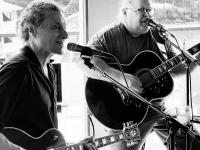Walking over the numbers
When it comes to biking and walking in the Twin Villages, the people have spoken.
Well, more than 200 of them.
The results from a biking and walking survey have been released, and the results show that while people in Newcastle and Damariscotta do walk and bike, there are a few trouble areas around town.
Lincoln County Regional Planner Robert Faunce wrote in an email that the bike survey that has been carried out since late 2014 has wrapped up — and the results reveal several wants, needs, opinions and concerns regarding biking in the Midcoast.
When first brought forth to both the Newcastle and Damariscotta selectmen in 2014, Faunce said the survey could help the area shape its biking and walking plans and eventually send those plans to the Maine Department of Transportation.
Faunce listed some of the highlights from the survey in his email, including that 208 people completed the surveys, and that while that number was good, he would have liked more respondents from Damariscotta and Newcastle.
Of that number, approximately 60 percent of the respondents claimed to still be in the workforce, and safety was the most often cited reason for what prevented more local biking.
Another 46 individuals expressed interest in working to improve the biking and pedestrian facilities in the area.
The most popular listed bike routes included Bristol Road, Route 1B, Biscay Road and Academy Hill in Newcastle. Bristol Road was also cited by cyclists and pedestrians for needing the most improvement. The town of Damariscotta was awarded a grant for extended sidewalks by the MDOT, although work has yet to start. Faunce wrote in the survey analysis that a lot of the respondents either lived on Bristol Road, or in Bristol.
Approximately 90 percent of the respondents wrote that they walked at least once a week in the area and that the downtowns were the preferred walking spots. Dodge Point, Academy Hill, Church Street and Glidden Street were also named as the top walking destinations. On the flip side, the Route 1B-Biscay Road-Church Street intersection near McDonald's was named the largest problem intersection in the survey, and the one where a crosswalk was most often requested.
According to MDOT regulations, a crosswalk cannot be installed unless there is a walkway on either side of the road, which there is not, at the Route 1B-Biscay Road-Church Street Intersection, according to Faunce.
Another sidewalk cited as needing improvement was the section in front of Rising Tide on Main Street.
Of the approximate 150 people who responded to the question of number of miles walked per week, the median answer was 7.3 miles per week.
Faunce reported that three quarters of respondents owned a bike, but that only a third of that number bike regularly. Faunce said the safety concerns likely curbed bike usage.
The Sheepscot Village, Newcastle Village and Great Salt Bay walking and biking paths were supported by upwards of 98 percent of the respondents, Faunce wrote.
The bike and pedestrian survey also included local students, and of those students 90 percent were enrolled at Great Salt Bay Community School in Damariscotta.
Faunce reported that very few of the students walked or biked to school, but also said it was understandable given the lack of sidewalks.
While approximately half of the school-aged respondents reported biking weekly, a third said they don't bike due to a lack of facilities, and those who do bike mainly do so in their communities.
Before anything further is done, Faunce said he will be bringing the information, and potential projects to the various towns involved with the bike and pedestrian plan within the next few weeks. The next scheduled meeting will be at 6 p.m. in Damariscotta on Wednesday, March 11 at the town office.
Event Date
Address
United States






















